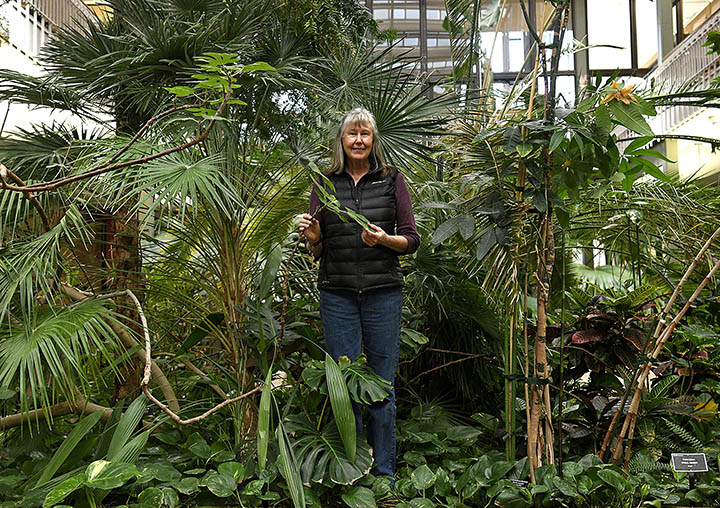A living legacy

A laurel fig tree grows over 40 feet tall in 37 years. At least, the one in the student union at the University of Montana (UM) did.
Kelly Chadwick, ’77, planted it in the building’s atrium when she first started her job there back in 1983.
“I never got bored,” Chadwick said of her long tenure as the University Center Garden Manager. “I was so lucky to fall into my job: It suited me so well and I loved it. If you get to know plants, you can always get to know more.”
Chadwick gained her horticultural know-how on-the-job, but said her liberal arts education at EOU prepared her for a career of continual learning.
The University Center was designed around massive planters positioned beneath a glass ceiling, so Chadwick’s first task was to fill out the oversized terrarium with plants that would thrive inside. Along the way, she ran into a few challenges presented by indoor gardening.
“Indoor gardens are limited by temperature and light,” she said. “It’s a totally unnatural environment.”
Even with a glass ceiling, the tropical plants required supplemental lights to artificially extend the day length. Chadwick installed a pond to increase humidity in the planters, but pruning and pest control were the biggest challenges to managing a jungle of tropical plants.
“We flooded the building several times by overflowing planters,” she said. “Controlling insects is the hardest thing to do, but most beneficial insects stay up high and eat the bad insects.”
Chadwick has released 10 batches of 1,500 tiny parasitic wasps and five swarms of 500 ladybug-like beetles to keep leaf-eaters at bay.
“It’s a cruel little world, but benign to people,” she said. “These species don’t care about people at all, and predators in general follow a curve that’s in balance with prey.”
She also developed a team of student workers who hunted insects and used non-toxic means of controlling pests. But the hours of work by Chadwick and her crew paid off when visitors were blown away by the living centerpiece of the student center.
“I planted almost every one of the plants in that garden, so I’m attached,” Chadwick said. “I’m simply growing plants, but at the same time I’m constantly educating myself and students.”
She selected specific varieties that could enhance educational opportunities. Biology and pharmacy classes have observed, touched and smelled medicinal plants humans have shaped for millennia.
“The initial value is beauty and making the building attractive, but it has many uses: breaking up sound, providing oxygen,” she said. “Plants are important and plants can be used in an educational way.”
She takes that approach outdoors, to a native garden that’s been cultivated for decades on the UM campus. Chadwick is part of a cohort of volunteers who nurtured renewed interest in the plot of flowers and shrubs that have adapted to Montana’s harsh conditions.
She credits lectures and field trips from the native plant society with much of her botanical education. Chadwick went on to serve as a volunteer coordinator and organized those field trips for 15 years. She also expanded the range of species with several new gardens. She helps maintain the gardens year-round, and has been meticulously recording the first flower opening for every species for 7 years.
“I love those native gardens, somehow my heart is in those gardens,” Chadwick said. “I found a group of kind, generous, admirable, humble people—they’re the heart of that garden. I just hope I can continue that passion with a new generation of outstanding people.”
Chadwick even chooses hikes based on finding a particular plant. She’s passionate about connecting people to native plants even if they can’t make it to the peaks and crags where they occur naturally. The garden also increases habitat for pollinators, and inspires visitors and students to plant native species at home.
Creative writing classes toured the garden to practice observing and capturing nature in words. Environmental studies students have done projects there, too, and a vegetable garden grows food for students, staff and the food pantry.
Chadwick sees plants as a gateway for connection, and an opportunity for humility.
“If you really look at plants, they have adapted so well and they are so detailed,” she said. “If you stop and look at a little white flower, there’s this intricate detail. Plants can make you pay attention.”
She’s worked with peers who can identify a plant from the impression of a leaf in the snow. Their place in the ecological web is equally complex inside as outside.
“Plants are interconnected with us,” Chadwick said. “They are critical for our survival. They’re our food, they prevent erosion, they provide habitat, they’re material for our clothes, but they’re also important for their own sake and interesting on their own. They’re pretty amazing creatures.”
Happy houseplants
Alumna Kelly Chadwick cared for some really big indoor plants, and she has a few tips for anyone whose houseplants could use a lift.
- Most people care too much. Many people over-water their plants. Chadwick said it’s the No. 1 killer, and most plants do best when they’re allowed to almost dry out between waterings. Choose one day a week to water your plants. Always check first to see if the soil is dry, and leave it alone if it’s still damp.
- Plants change seasonally, even inside. Differences in temperature and day length affect indoor plants, too. Running an air conditioner or a fireplace can affect the humidity in each room. Chadwick recommends being aware of the changing environment inside and out.
- Touch your plants! A plant’s leaves can tell you about water needs. If they’re firm, that means there’s moisture. Soft leaves mean the soil is drier.
